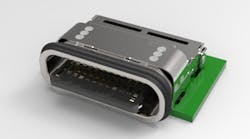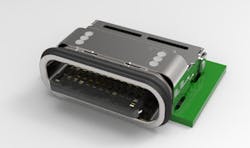As consumer products become denser, transfer larger files, have increased power needs, and are used in more demanding environments, traditional connectivity solutions don’t measure up. While legacy USB and Micro USB connectors have been the standard for connectivity, USB Type-C is becoming the preferred connector solution for consumer products because it offers higher performance, combined power and data connectivity, and a form factor that fits today’s products. True IPX8-rated waterproof versions of USB Type-C connectors are increasingly needed to meet customer requirements.
In this article, we’ll look at the advantages of USB Type-C connectors and discuss selection and design considerations for using waterproof USB Type-C connectors.
Connectivity Trends
Waterproof products are a trend in the industry because users want to be able to take their devices with them wherever they go. The iPhone, Samsung Galaxy, Huawei’s high-end phones, and other mobile phones tout their water resistance as one of the attributes that consumers want. This attribute also applies to other products like electric shavers, electric toothbrushes, POS terminals, and wearables, as well as automotive, medical, and industrial products. The last thing users need to worry about is environmental sensitivity in an electrical product.
Waterproof USB Type-C receptacles deliver more power, faster data-transfer speeds, and environmental protection for consumer products. (Courtesy of TE Connectivity)
Another trend is faster operation—users want products to transfer data and charge up more quickly. The market is transitioning from Micro USB to USB Type-C because USB Type-C delivers far higher power and data rates. For example, a product with Micro USB might have used 0.9 A (with USB 3.0), but with USB Type-C it can use 5 A, so it can charge much faster. And while Micro USB data-transfer rates were in the 5-Gb range, USB Type-C data transfers can deliver up to 10 Gb/s. This extra speed makes a big difference when transferring large files from one device to another.
Finally, ease of use is a constant goal for many designers. USB Type-C connectors are easier to use than Micro USB because they offer flip insertion (no specific connector orientation is required when inserting them).
Key Requirements
Some important requirements to consider in a USB Type-C solution that supports these trends are:
Signal integrity: Higher signal integrity equals faster data rates, so USB Type-C products with optimum signal integrity are preferred and should be rated for USB 3.1 performance. In some cases, manufacturers have leveraged their experience with previous data products to deliver 10-Gb/s throughput.
Power: USB Type-C products can transfer more power—100 W at 5 A compared to 10 W at 0.5 A in a Micro USB system. Therefore, devices can charge more quickly, assuming the rest of the system is designed for faster charging.
Environmental protection: To provide the environmental protection required by users, waterproof USB Type-C connectors leverage a rubber seal and a seamless housing to keep water out. These connectors should be rated for IPX8 water-ingression performance (per IEC 60529) and should be durable enough for thousands of mating cycles. Added board-retention features help make for a robust design, providing high reliability and quality.
USB Type-C connectors with IPX8 waterproofing performance are becoming the new standard for a wide range of products because they deliver go-anywhere reliability, faster charging, and faster data transfers. Micro USB has had a good history of delivering connectivity in a wide range of products, but USB Type-C is the connector of the future.
Tommy Yu is Product Manager at TE Connectivity.


